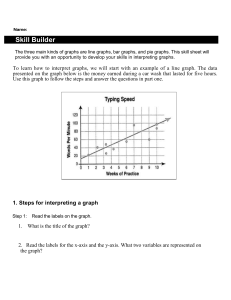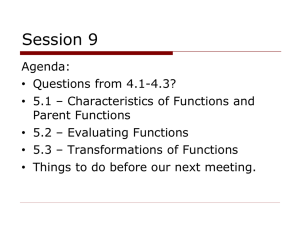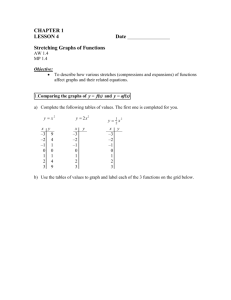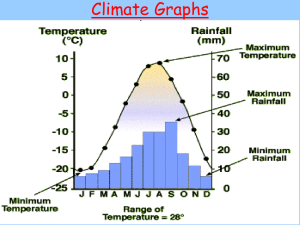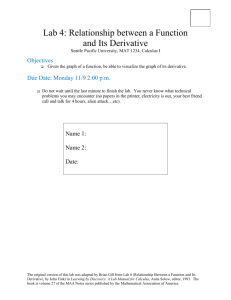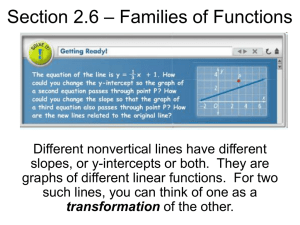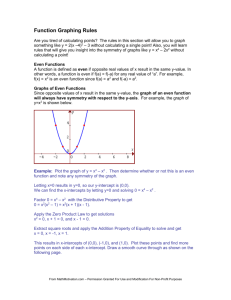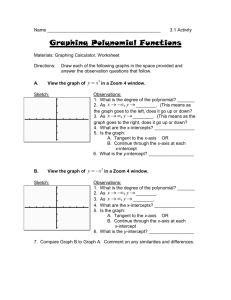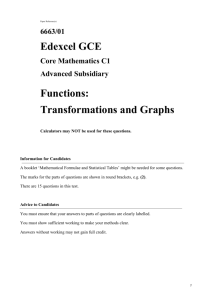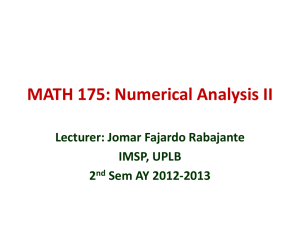Notes 3.2
advertisement
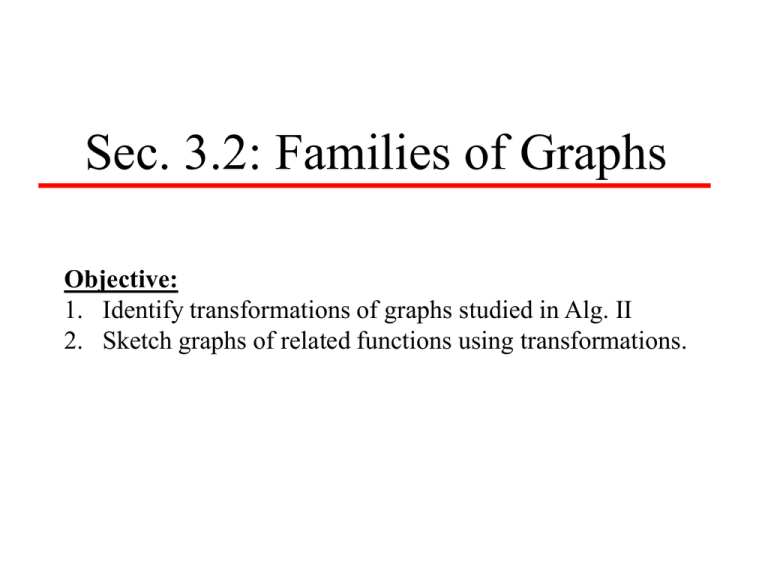
Sec. 3.2: Families of Graphs Objective: 1. Identify transformations of graphs studied in Alg. II 2. Sketch graphs of related functions using transformations. Pre-Calculus Section 3.2: Families of Graphs All parabolas that we studied in algebra II are related to the basic graph of y = x2. parent graph of the family of parabolas. This makes the graph of y = x2 the ______________ one or _______ more similar characteristics. A family of graphs is a group of graphs that share _______ transformed to create other members in a family of A parent graph is a basic graph that is _____________ graphs. Some different parent graphs are shown below: Reflections and translations can affect the appearance of the graph. reflection flips the figure over a line called the axis of symmetry or line of symmetry. A ___________ Examples: 1. Graph f(x) = x3 and g(x) = -x3. Describe how the graphs of g(x) and f(x) are related. y = x3 y = - x3 𝑥 𝑦 0 0 1 1 2 8 −1 − 1 −2 − 8 𝑥 𝑦 0 0 1 −1 2 −8 −1 1 −2 8 **The graphs are reflections of each other over the x-axis. -1 will make the graph reflect over the x-axis. Notice, multiplying a function by a ______ When a constant term C is added to or subtracted from a parent function, the result is a translation of the graph ___ up_or ________. down ____________ (EX: y = f(x) + c ) 2. Use the parent function y = x3 to sketch the graph of the function y = x3 – 1. Parent Function: y = x3 𝑥 𝑦 0 0 1 1 2 8 −1 − 1 −2 − 8 Since -1 is added to the parent function y = x3, the graph will shift down 1 unit. So each y-value shifts down 1 unit. When a constant C is added or subtracted from the x before evaluating the function, the right translation of the graph _______ left or _______. result is a _____________ (EX: y = f(x + c) ) 3. Use the parent function y = x3 to sketch the graph of the function y = (x + 2)3 Parent Function: y = x3 𝑥 𝑦 0 0 1 1 2 8 −1 − 1 −2 − 8 Since 2 is being added to x before being evaluated by the parent function, the graph will slide left 2 units. So each x-value will slide 2 units left. We can also have a graph that combines the two translations. 4. Graph the function y = (x – 1)3 + 3 Parent Function: y = x3 𝑥 𝑦 0 0 1 1 2 8 −1 − 1 −2 − 8 The parent function will slide 1 unit right and shift up 3 units. A ___________ dilation has the effect of shrinking or enlarging a figure. When the leading expanded or _____________. compressed coefficient of a function is not 1, then the function is __________ (EX: y = 3f(x) ) 5. Graph each function. Then describe how it is related to the parent graph. A. g(x) = 4x-1 The parent function is: y= 1 𝑥 4 The graph y = , is a vertical expansion 𝑥 by a factor of 4. B. 𝑥 𝑦 0 𝑢𝑛𝑑𝑒𝑓𝑒𝑖𝑛𝑒𝑑 1 1 1 2 2 1 4 4 −1 − 1 1 −2 − 2 1 −4 − 4 1 h(x) = − 4 𝑥 −1 + 3 The parent function is: y= 1 𝑥 Since the parent function is multiplied by -1, the graph is a reflection across the x-axis. The graph will then be vertically compressed by a factor 1 4 of . The graph will finally shift up 3 units. Each box = 0.5 The following table summarizes the relationships in families of graph. Change to Parent Function y = f(x) , c > 0 y = -f(x) Graph is reflected over the x-axis. y = f(-x) Graph is reflected over the y-axis y = f(x) + C Graph is translated up or down. y = f(x + C) Graph is translated rt. or lt. y = C f(x) , c > 1 y = C f(x) , 0 < c < 1 y = f(cx) , c > 1 y = f(cx) , o < c < 1 Graph is expanded vertically. Graph is compressed vertically. Graph is compressed horizontally. Graph is expanded horizontally. Other transformations may affect the appearance of the graph. We will look at two cases that change the shape of the graph. Examples: 6. Observe the graph of each function. Describe how the graphs in parts (B) and (C) relate to the graph in part (A). A. f(x) = (x + 1)2 – 2 Highest exponent is a 2, so graph must be a U-shape figure. Parent graph is : y = x2 𝑥 𝑦 0 0 1 1 2 4 −1 1 −2 4 The graph will slide 1 unit left and shift 2 units down. B. |f(x)| =| (x + 1)2 – 2| This transformation reflects any portion of the parent function that is below the x-axis, so that it is above the x-axis. So the graph we di in part(a) that is below the x-axis will reflect above the x-axis, and everything else stays the same. C. f(|x|) = (|x| + 1)2 – 2 This transformation takes the portion of the graph on the left of the y-axis being replaced by a reflection of the portion on the right of the y-axis. This means the right side of the graph is the same and the left side changes to the reflection of the right side.
